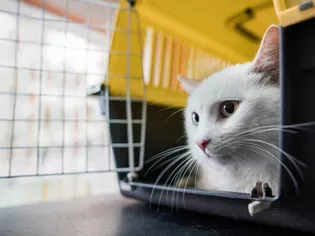Low Stress Travel to the Vet With Your Cat
Updated on 04/26/24

Stress-Free Veterinary Visits for Your Feline Companion: A Comprehensive Guide to Smooth Sailing
As responsible pet owners, we want our feline companions to receive the best possible care, and that includes regular veterinary check-ups. However, for many cats, the prospect of a trip to the vet can be a daunting experience, filled with anxiety and stress.
Fear not, dear cat lovers! With proper preparation and a few helpful techniques, you can transform your cat's veterinary visits into stress-free ventures. Join us as we embark on a comprehensive journey to ensure your furry friend's comfort and well-being during their medical encounters.
Step 1: Start Early, Start Gentle
Just like humans, kittens are more adaptable and open to new experiences than their older counterparts. Introducing veterinary visits from an early age can help kittens form positive associations with the process.
* Make it a Game: Use toys, treats, and play to create positive experiences around the carrier. Allow your kitten to explore it at their own pace, making sure it's a safe and comfortable space.
* Short and Sweet: Gradually increase the duration of time your kitten spends in the carrier. Start with short periods and gradually extend them, making sure to keep it positive and rewarding.
Step 2: Choose the Right Carrier
A comfortable and secure carrier is essential for minimizing stress during travel. Consider the following tips:
* Size Matters: Choose a carrier that is large enough for your cat to stand up, turn around, and lie down comfortably.
* Soft and Snug: Opt for carriers with soft, padded interiors or add your own blankets or towels to provide extra comfort.
* Ventilation is Key: Ensure there is ample ventilation to prevent feeling stuffy or overheated.
Step 3: Calming Aids and Supplements
If your cat experiences significant anxiety during travel, consider using calming aids or supplements. Consult your veterinarian before using any products to ensure they are safe and appropriate for your pet.
* Natural Remedies: Essential oils like lavender and chamomile have calming effects. You can diffuse them in the room or apply them topically (after diluting with a carrier oil).
* Pheromone Diffusers: Synthetic pheromone diffusers mimic the calming pheromones released by mother cats, creating a sense of security and comfort.
* Calming Supplements: Supplements like L-theanine, tryptophan, and valerian root can help reduce anxiety and promote relaxation.
Step 4: Travel Day Best Practices
On the day of the appointment, follow these tips to minimize your cat's stress:
* Avoid Food and Water Beforehand: Restrict food and water for several hours before the appointment to reduce the risk of motion sickness.
* Keep it Calm: Maintain a calm and reassuring demeanor during travel. Avoid sudden movements or loud noises that could startle your cat.
* Place a Familiar Object: Put a piece of your cat's favorite blanket or toy in the carrier to provide comfort and familiarity.
Step 5: At the Veterinary Clinic
Once at the clinic, there are steps you can take to help your cat stay relaxed:
* Request a Quiet Room: Ask the staff if a quiet room is available for your cat's exam. This can help minimize distractions and reduce anxiety.
* Spend Time with Your Cat: Stay with your cat during the exam as much as possible, providing a calming presence and reassurance.
* Use Treats and Praise: Reward your cat with treats and praise throughout the experience to reinforce positive behavior.
Additional Tips for Specific Cat Personalities
* The Shy and Anxious Cat: Provide plenty of hiding places in the carrier and cover it with a blanket to create a sense of security.
* The Active and Energetic Cat: Use a carrier with a large enough space for them to move around. Offer interactive toys or treats during travel to keep them occupied.
* The Senior Cat: Choose a carrier that is easy to access and handle. Use extra padding to provide comfort.
* The Cat with Medical Conditions: Discuss your cat's specific needs with the veterinarian and make necessary arrangements for transportation and care.
Remember, every cat is different, so tailor these tips to meet your pet's individual needs and preferences. With patience, preparation, and a sprinkle of love, you can make veterinary visits a stress-free and positive experience for your cherished feline companion.
Explore More Pets

Cat Behavior Problems
How to Stop Aggression in Kittens

Long-Haired Cat Breeds
Siberian Cat: Breed Profile, Characteristics, & Care

Cat Behavior Problems
How to Stop Kittens From Scratching and Biting

Long-Haired Cat Breeds
Turkish Angora: Cat Breed Profile, Characteristics & Care

Basic Training
How to Socialize Your Kitten

Short-Haired Cat Breeds
Cute Pictures & Facts About Calico Cats & Kittens

Litter Box Training
Training Your Kitten to Use the Litter Box

Long-Haired Cat Breeds
10 Fun Facts About White Cats